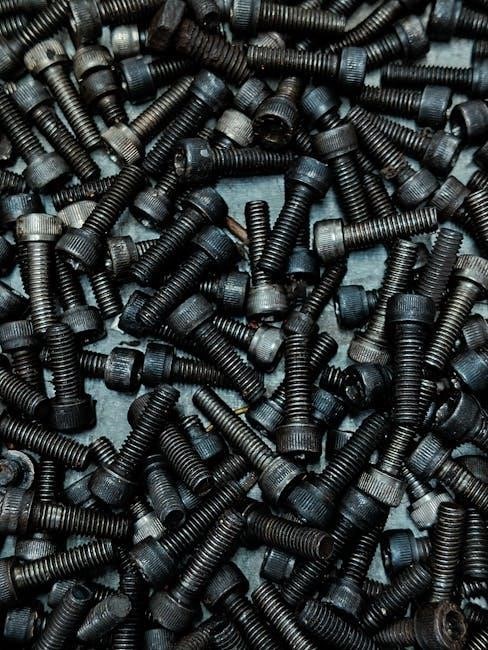5.7 Hemi Head Bolt Torque Sequence: An Overview

The 5.7 Hemi engine, a third-generation marvel, boasts a cast iron block with aluminum heads. Achieving proper head bolt torque is crucial for optimal performance and preventing leaks. This overview outlines the correct procedure and specifications for ensuring a secure head seal.
The 5.7-liter Hemi engine, a prominent member of the third-generation Hemi family, is renowned for its robust performance and innovative design. Introduced as a modern iteration of the classic Hemi architecture, this engine features a cast iron block, typically incorporating four-bolt main bearings for enhanced durability. Forged connecting rods contribute to the engine’s strength, while lightweight aluminum pistons aid in responsiveness and efficiency.
The cylinder heads are constructed from aluminum, facilitating improved heat dissipation and reduced weight. The design allows for efficient airflow and combustion. Proper maintenance, including adhering to the correct head bolt torque sequence, is crucial for preserving the engine’s integrity and performance. This ensures a tight seal between the head and the block, preventing leaks and maintaining optimal compression. Understanding the 5.7 Hemi’s construction is paramount for proper servicing.
Paying close attention to torque specifications and recommended procedures can significantly extend the life of the engine. Following instructions prevents damage and ensures the engine performs to its full potential.
Engine Block and Head Material
The 5.7 Hemi engine utilizes specific materials for its block and heads, each chosen for their unique properties and contributions to overall engine performance. The engine block is predominantly constructed from cast iron, a material known for its robust strength, durability, and ability to withstand high levels of stress and pressure generated during combustion. This choice of material ensures the engine’s structural integrity and longevity, particularly under demanding operating conditions.
In contrast, the cylinder heads of the 5.7 Hemi are manufactured from aluminum. Aluminum offers several advantages, most notably its lightweight nature, which contributes to reduced overall engine weight and improved vehicle handling; Furthermore, aluminum exhibits excellent thermal conductivity, facilitating efficient heat dissipation from the combustion chambers. This helps to maintain optimal operating temperatures and prevents overheating, thereby enhancing engine performance and reliability.
The combination of a cast iron block and aluminum heads strikes a balance between strength, weight, and thermal management. This ensures that the 5.7 Hemi can deliver power while maintaining durability and efficiency.

Head Bolt Torque Specifications
Accurate torque specifications are critical for the 5.7 Hemi engine. M12 and M8 bolts require different torque values. Following the correct sequence and specified torque ensures proper head gasket sealing and prevents engine damage.
M12 Bolt Torque Stages
The M12 bolts, crucial for securing the cylinder heads on the 5.7 Hemi engine, necessitate a specific torque sequence performed in multiple stages. This multi-stage approach ensures even distribution of clamping force across the cylinder head, preventing warping and guaranteeing a reliable seal. The process begins with an initial, lower torque value, followed by an intermediate torque setting, and culminating in an angle torque application.
Each stage plays a critical role in achieving the correct final clamping force, essential for optimal engine performance and longevity. Skipping a stage or deviating from the specified torque values can lead to gasket failure, coolant leaks, or even more severe engine damage. Precision and adherence to the recommended procedure are paramount. Using a quality torque wrench and angle measuring tool is highly recommended for accuracy. The subsequent sub-sections will detail each stage with precise torque values and instructions.
Stage 1: Initial Torque (25 ft-lbs)
The first stage in the M12 head bolt torque sequence for the 5.7 Hemi involves tightening the bolts to an initial torque of 25 ft-lbs (34 Nm). This initial tightening serves as a preliminary seating process for the cylinder head against the engine block, ensuring uniform contact before applying higher torque values. It’s crucial to follow the correct torque sequence during this stage, as uneven tightening can introduce stress and potentially distort the head.
Using a calibrated torque wrench, gradually increase the torque on each bolt in the specified sequence until you reach 25 ft-lbs. Avoid over-torquing at this stage, as it can compromise the subsequent stages. This initial torque ensures the head is properly aligned and prepared for the next, more critical tightening phases. This step ensures proper alignment.
Stage 2: Intermediate Torque (40 ft-lbs)
Following the initial torque of 25 ft-lbs, the next step in the M12 head bolt torque procedure for the 5.7 Hemi is to increase the torque to an intermediate value of 40 ft-lbs (54 Nm). This stage further compresses the cylinder head gasket, ensuring a more secure and uniform seal between the head and the engine block. As with the initial torque stage, maintaining the correct torque sequence is paramount to avoid any warping or uneven pressure distribution across the head.
Using a calibrated torque wrench, carefully tighten each bolt in the designated sequence until the wrench reads 40 ft-lbs. It’s important to proceed slowly and smoothly, avoiding any jerky movements that could lead to inaccuracies. This intermediate torque prepares the bolts for the final angle torque stage, where the final clamping force is applied. Maintaining proper torque is very important.
Stage 3: Angle Torque (90 Degrees)
The final stage in securing the 5.7 Hemi cylinder heads involves angle torque, specifically a 90-degree turn, after achieving the intermediate torque of 40 ft-lbs. This method ensures precise and consistent clamping force, going beyond simple torque values. Using a torque angle meter, or a wrench with angle measurement capabilities, carefully rotate each M12 head bolt, in the correct sequence, an additional 90 degrees.
This rotation stretches the bolt within its elastic range, providing the necessary clamping force for a reliable seal. Ensure accurate angle measurement for each bolt. Proceeding slowly and steadily is crucial. Avoid over-rotation, as it can damage the bolt or the threads in the block. This final step is critical for proper head gasket compression and long-term engine performance, preventing leaks and maintaining optimal combustion sealing.
M8 Bolt Torque Specifications
In addition to the larger M12 bolts, the 5.7 Hemi cylinder heads also utilize smaller M8 bolts. These bolts require a different torque specification than the M12 bolts. This ensures that they’re properly tightened without over-stressing them. The M8 bolts typically have a two-stage torque process.
The initial stage involves tightening them to a lower torque value, followed by a final torque value to achieve the desired clamping force. It is essential to follow the correct sequence for tightening the M8 bolts in relation to the M12 bolts. Using the wrong torque on the M8 bolts can result in leaks or damage to the cylinder head. Always consult the engine repair manual for the specific M8 torque values. Accurate torque application with a quality torque wrench is crucial for reliable engine operation.
Initial Torque for M8 Bolts (15 ft-lbs)
The initial torque stage for the M8 bolts is a critical step in the overall head bolt tightening process. This initial torque setting brings the bolt into contact with the cylinder head and begins to compress the head gasket evenly; It is vital to use a calibrated torque wrench to ensure accuracy during this stage. Applying 15 ft-lbs of torque to the M8 bolts prepares them for the subsequent final torque application.
This initial step helps prevent distortion of the cylinder head and ensures proper gasket seating. It also sets the stage for an accurate final torque reading. Following the correct torque sequence while applying the initial torque is just as important as the torque value itself. A systematic approach to tightening helps distribute stress evenly across the head. Remember, precision at this stage contributes to a reliable and leak-free engine seal.
Final Torque for M8 Bolts (25 ft-lbs)
After the initial torque of 15 ft-lbs, the next crucial step is applying the final torque of 25 ft-lbs to the M8 bolts. This final tightening ensures that the bolts are properly secured and the cylinder head is firmly seated against the engine block. Using a reliable torque wrench is paramount for achieving accurate and consistent results.
During this stage, it’s important to maintain the correct torque sequence to distribute pressure evenly across the head gasket surface. Uneven tightening can lead to leaks or even head gasket failure. The 25 ft-lbs specification ensures that the M8 bolts contribute effectively to the overall clamping force. Double-check each bolt to guarantee that the final torque has been accurately applied. Take your time and focus on precision to create a durable and leak-proof seal.

Torque Sequence
Following the correct torque sequence is vital for the 5.7 Hemi. This ensures even pressure distribution across the cylinder head. Precise execution prevents warping and potential gasket failure, ensuring optimal engine performance.
Importance of Correct Sequence

The correct torque sequence is paramount when securing the cylinder heads on a 5.7 Hemi engine. Deviating from the specified order can lead to uneven pressure distribution across the head gasket. This unevenness can cause several detrimental effects, potentially compromising the engine’s performance and longevity.
Firstly, an incorrect sequence can cause warping of the cylinder head. Aluminum heads, commonly used in the 5.7 Hemi, are particularly susceptible to distortion under uneven stress. Warping can lead to combustion leaks, coolant intrusion, and oil contamination, all of which can severely damage the engine.

Secondly, improper torque sequencing can result in premature head gasket failure. The head gasket is designed to create a tight seal between the cylinder head and the engine block. Uneven pressure can crush or damage the gasket in certain areas, leading to leaks and a loss of compression. Loss of compression will result in power loss and poor fuel economy, and can cause catastrophic engine damage.

Therefore, adhering to the manufacturer’s specified torque sequence is crucial. This ensures that the clamping force is distributed evenly across the entire cylinder head, creating a reliable and durable seal. A properly torqued head minimizes the risk of warping, gasket failure, and subsequent engine problems.
Step-by-Step Torque Sequence
The correct torque sequence is vital for a secure head gasket seal on the 5.7 Hemi. Following these steps ensures even pressure distribution and prevents warping or leaks. Begin by ensuring all bolts are clean and lightly oiled.
Step 1: Snug tighten all M12 cylinder head bolts (numbered 1-10) in the specified sequence to 25 ft-lbs (34 Nm). Similarly, snug tighten the M8 bolts (numbered 11-15) to 15 ft-lbs (20 Nm), again following the correct sequence. It is very important to follow the numbers in the correct order.
Step 2: Increase the torque on the M12 bolts (1-10) to 40 ft-lbs (54 Nm), maintaining the original sequence. At this stage, do not adjust the torque on the M8 bolts.
Step 3: Using an angle torque gauge, rotate each of the M12 bolts (1-10) an additional 90 degrees, following the initial sequence. This final angle torque ensures proper bolt stretch and clamping force.

Step 4: Finally, increase the torque on the M8 bolts (11-15) to 25 ft-lbs. This completes the torque sequence.
Always refer to a reliable repair manual for the specific torque sequence diagram for your 5.7 Hemi engine. Use a calibrated torque wrench and angle gauge for accurate results.

Additional Bolt Information
Beyond head bolts, other fasteners like rocker shaft and main cap bolts are crucial. Proper torque on these components ensures engine reliability and performance. Always consult specifications for each bolt type and location.

Rocker Shaft Bolt Torque
Securing the rocker shafts correctly is vital for proper valve train function in the 5.7 Hemi. The correct torque prevents excessive wear, noise, and potential engine damage. The tightening procedure involves multiple steps to ensure even distribution of pressure across the rocker shaft assembly.
Initially, snug the rocker shaft bolts to approximately 10 Nm (7 ft-lbs) using a torque wrench. This preliminary step helps seat the components correctly. Following the snug tightening, increase the torque to 23 Nm (17 ft-lbs) to firmly secure the rocker shafts.
Finally, after reaching the specified torque, it’s crucial to individually loosen each bolt by approximately 1/2 turn. This seemingly counterintuitive step helps relieve any residual stress and ensures the rocker shaft assembly is properly aligned and seated. This process is essential for optimal valve train operation and longevity. Neglecting this step can lead to premature wear and potential valve train issues. Always adhere to the specified torque values and loosening procedure for the 5.7 Hemi rocker shaft bolts.
Main Cap Bolt Torque
The main cap bolts are critical for securing the crankshaft within the 5.7 Hemi engine block. Correct torque is essential to maintain proper crankshaft alignment and prevent premature bearing wear or engine failure. The main cap bolts are typically torqued in multiple stages to ensure even clamping force across the main bearings.
While specific torque values may vary slightly depending on the exact 5.7 Hemi engine model, a common procedure involves an initial torque followed by an additional angle torque specification. For M8 main cap bolts, a typical sequence may involve first torquing the bolts to 15 ft-lbs. Following this initial torque, the bolts are then further tightened to 21 ft-lbs.
It’s important to consult the specific service manual for your 5.7 Hemi engine to confirm the exact torque specifications and tightening sequence for the main cap bolts. Always use a calibrated torque wrench and adhere to the specified procedures to ensure proper crankshaft support and engine reliability. Neglecting to torque the main cap bolts correctly can lead to severe engine damage.